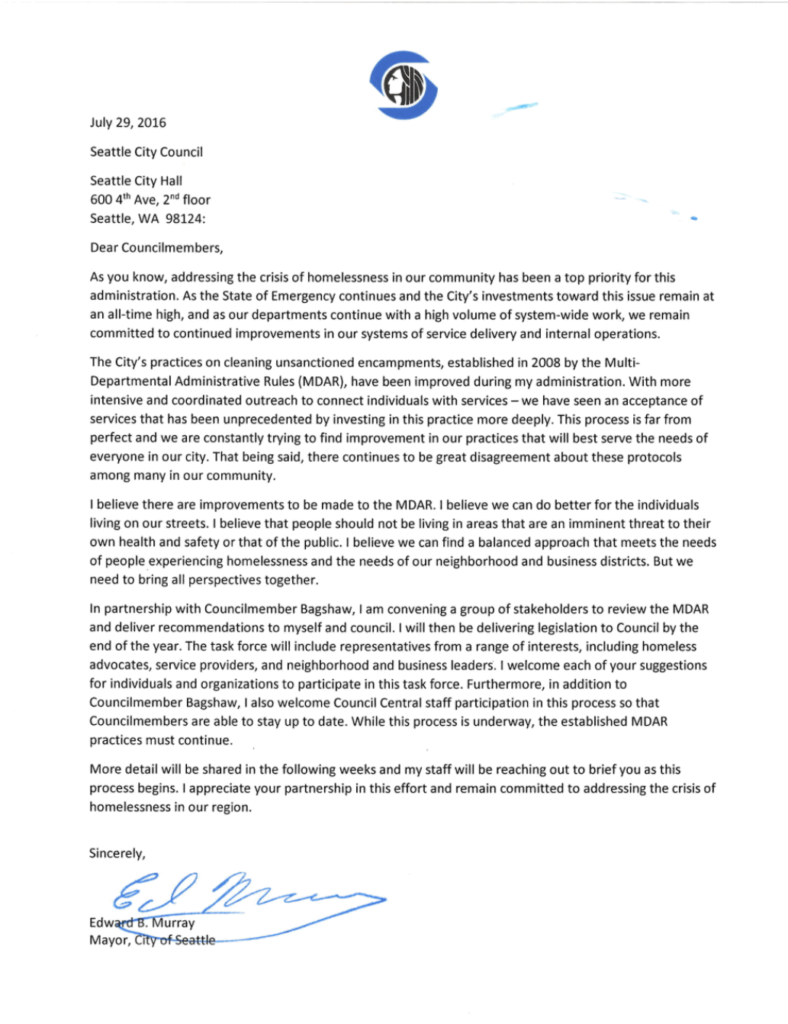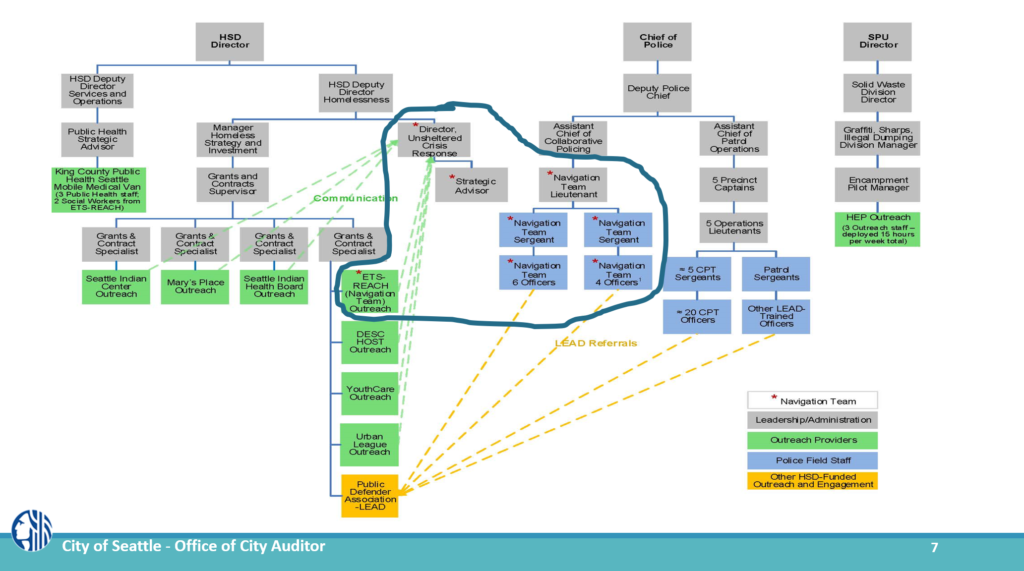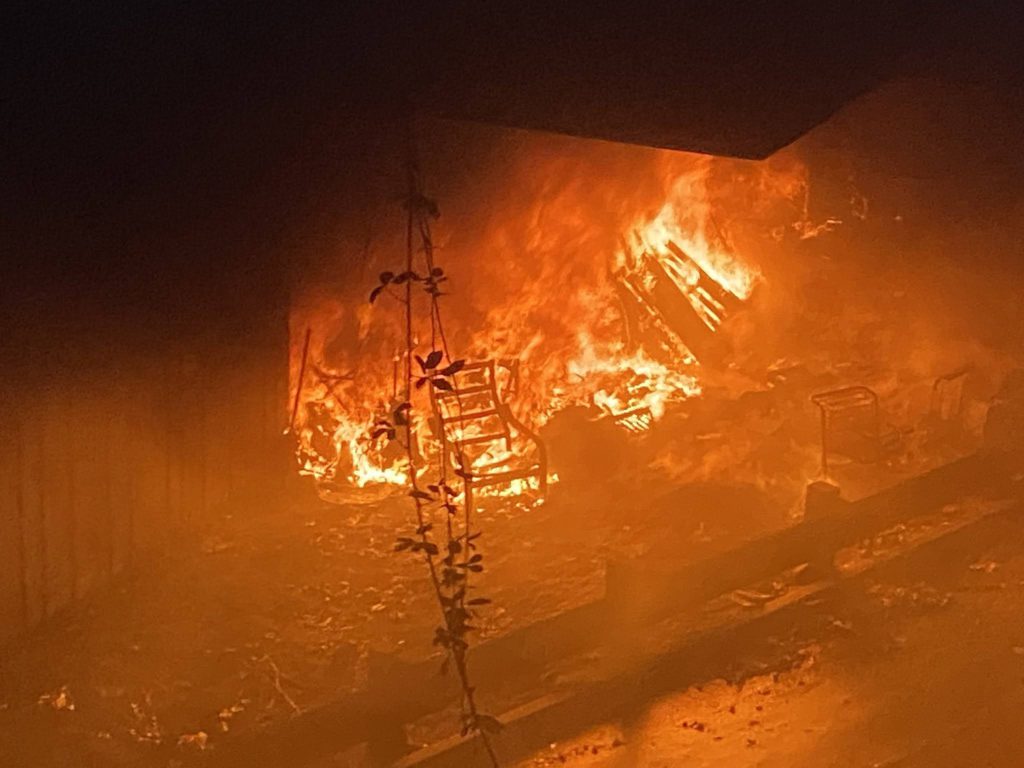If you wanted to design a real-life test to determine if a civic leader’s actual virtue exceeds their desire to signal it, you could hardly do better than the life-and-death experiment playing out on Interstate Highways 5 and 90 in Seattle right now.
So far, our desire to signal virtue is winning.
UPDATE, July 22 2021: Brandi Kruse and others are reporting that two encampments near I-90 are being cleared today, after more than four months of rock and debris-throwing reports.
180+ Rock Throwing Incidents in 2021
At this writing, there are now more than 180 rock or debris-throwing incidents in 2021 alone. Most, but not all, are at or near the I-5/I-90 crossover. There are four or five per day, for the past four days.
Think of that: every single day, 5 bricks, rocks or chunks of concrete are tossed onto a 60mph+ freeway.
The uncomfortable reality is that most if not all of these incidents have been traced to homeless encampments adjacent to our highways. Rock-throwing wasn’t happening ten years ago — or perhaps more accurately, if it ever was, it was an isolated incident or two, not five per day. These rocks aren’t just randomly appearing.
And it’s not just one individual:
Someone Is Going To Get Seriously Hurt or Killed
I haven’t calculated the precise odds of death or life-altering injury with five randomly tossed concrete shards, rocks or bricks onto a 60mph+ freeway over every 24 hour period. But the odds of loss of life (or life-altering injury) has got to be a better-than 50/50 bet over the course of a month, don’t you think?
Honestly. It is only a matter of time before one or more innocent people get killed. It’s miraculous that no one thus far has.
Until leaders act, the question is: who will it be? If you drive on I-5 or I-90 near Seattle, you’re in the deadly lottery.
How Are We Letting This Happen?
You rightly ask: How can we let this happen? Why can’t we say “This is not acceptable,” and enforce the law? Numerous “brush fires” stemming from encampment along the highway are one thing, but now rocks? Why do we allow unsanctioned encampments adjacent to major freeways, yet prevent unauthorized encampment in state parks?
The reality is, there’s a conflict-avoidant tendency in Seattle’s municipal leadership. It’s far less costly to simply go along with the fiction that these unsanctioned encampments pose little safety risk and that allowing them to set up wherever they’d like on public property is the “compassionate” thing to do.
The issue of encampment “sweeps” has been an enormously contentious one in Seattle for the past eight years or so. And activists have, for now, forced city officials to press the “pause” button.
Yet the preamble of the Seattle City Charter is clear. The purpose of a city government is first and foremost to protect and enhance the health, safety, environment and general welfare of the people. In fact these goals are the very reason for the City and its laws:

Who’s In Charge?
Shouldn’t there be a city-coordinated group that helps remove or relocate encampments when they pose a clear risk to public safety, offering shelter and services, but also saying “no, you cannot stay here?” There used to be such a team. But first, a few words about its origin.
Encampment Removal Pre-2016: Disorganized, Miscommunication
Before the existence of the Navigation Team, the City was involved in mandatory encampment removals, but often with little coordination, advanced warning, safety for encampment residents, or clear ownership.
In January 2016, Seattle City Council held a briefing on sweeps of unauthorized tent encampments. If you follow this thread from the Seattle Times’ David Beekman, you’ll see that Kshama Sawant, Lisa Herbold, and Lorena Gonzalez all expressed strong concerns about sweeps of unauthorized encampments:
The January 2016 Council briefing on unauthorized encampment removals is here:
Among other things mandated was a specific multi-department administrative rule (MDAR) laying out some basic precepts for unsanctioned encampment removal:

Over the ensuing months, Mayor Ed Murray acknowledged ongoing coordination problems, and wrote the following to City Council, saying specifically “I believe that people should not be living in areas that are an imminent threat to their own health and safety or that of the public”:

In August 2016, Mike Baker of The Seattle Times wrote about the flawed and disorganized results when there’s no coordination between service providers and law enforcement.
Baker’s article is here: “Chaos, trash and tears: Inside Seattle’s flawed homeless sweeps“
October 2016: “The Jungle”
In October 2016, the City of Seattle moved ahead and cleared an area under I-5 commonly known as “The Jungle”:
“Amid loud chants from protesters, city and state officials began clearing out a Seattle homeless encampment known as ‘The Jungle’ Tuesday. The camp is notorious for multiple cases of criminal activity and drug use. The homeless still living in The Jungle were warned they needed to leave the area under Interstate 5 by 8 a.m. Tuesday. Officials say 13 people were still there as of early Tuesday morning, down from over 350 people last year. And those 13 were still not ready to go.”
KING 5 News, October 11 2016
Concerns about lack of coordination, a desire to establish more humane approaches and clear ownership drove the formation of the Navigation Team in November 2017, which combined outreach service providers and law enforcement to help better coordinate these efforts.
What was the Navigation Team? How Did It Work?
Seattle’s short-lived “Navigation Team,” a combined team of outreach service providers and law enforcement, was established in Feburary 2017. It was the brainchild of Scott Lindsay, Mayor Ed Murray’s Public Safety Advisor.
The Nav Team was a combined group of service providers (i.e., shelter and service providers) and police officers who would make contact with an encampment posing a hazard risk.

They would go the encampment which was deemed by the Executive Branch (Mayor’s office) to be a public safety risk, several days ahead of time, make contact, and warn them they cannot stay, offering shelter and service referrals. Then a couple days before. Then day of.
Feb 2017- Aug 2020
The Navigation Team used to do the difficult but important work of clearing unsanctioned encampments when they posed a clear hazard to public health or safety.
From the moment it started, the Nav Team ran into constant opposition from outspoken Councilmember Kshama Sawant, amplified by Seattle’s cadre of activist-journalists, as well as Seattle’s leftmost Twitterati. You can search Twitter for #stopthesweeps Seattle to get an idea of who holds such a view; it includes the Seattle Democratic Socialists Alliance and several highly-followed Twitter users.
Legislatively, from 2017-2019, Kshama Sawant worked hard to defund this team and end its work, both rhetorically and through proposed bills. In November 2019, a bill to fully defund the team and reallocate its 30+ members was considered and rejected by City Council’s Budget Committee. That was put forward by Sawant, but failed to get a second, and never made it out of committee.
During this period from 2017-2020, Council members became increasingly hostile to ever clearing designated unsanctioned encampments (often shorthanded as “sweeps”) of any kind. Kshama Sawant led this messaging, but by August 2020, Councilmembers like Teresa Mosqueda and Council President Lorena Gonzalez joined right in.
“Stop The Sweeps” Gains Momentum, 2017-2020
Socialist Alternative (Kshama Sawant’s political party) has been in the vanguard of the “Stop The Sweeps” movement. In 2017, their calls to end sweeps grew ever louder (“Stop the Sweeps! Nov. 1 Camp Out at Seattle City Hall“, SocialistAlternative.org)
There’s a Facebook group and Twitter group — Stop The Sweeps Seattle with over 3,500 members. They argue that (a) housing is a human right, and (b) forced displacement with a lack of adequate housing is inhumane. The most prominent Seattle politician aligning with these views is Councilmember Kshama Sawant:
From about 2018-2020, Council was ever-more captured by the message from the “stop the sweeps!” activist voices. Yet it wasn’t prepared to bring an end to these sweeps.
This all changed with the eruption of the George Floyd police brutality protests of June 2020. Activists finally had the anti-police momentum they needed.
On August 5th 2020, Seattle’s City Council defunded the Navigation Team. On that date, Council first voted unanimously to remove police from the Navigation Team, and then split 5-4 on a second vote to fully defund this team.
From a practical standpoint, the first vote to unanimously remove Seattle’s Police Department from these outreach teams ensured its demise, because — at least to hear the Navigation Team’s defenders in law enforcement say it — several service providers privately expressed an entirely reasonable desire to have law enforcement protection in the vicinity during these encounters.
The first unanimous vote to remove SPD from the Navigation Team undermines its efforts, for the same reason captured in Abraham Lincoln’s famous quotation that “Laws without enforcement are just… good advice.”
If well-meaning service providers and volunteers won’t reach out to unsanctioned encampments without law enforcement, if any who are encamped don’t voluntarily move on, the public hazard represented will not effectively change.
Activists declared the Navigation Team’s “sweeps” the “stealing of campers’ property!” and “uncompassionate!”, and vilified the city for doing it.
Rarely would they consider any needs of those to whom the encampments posed safety risks; these demands were pretty much exclusively from the campers’ points of view.
Yet less than a year later, in the wake of the George Floyd Protests, CHOP/CHAZ the opportunity presented itself. Lorena Gonzalez, Lisa Herbold and Teresa Mosqueda all jumped aboard. Eventually “Defund The Police by 50%” was supported by 7 of 9 Council members — all but Debra Juarez and Alex Pedersen.
And the Navigation Team was fully eliminated by City Council, in two votes, on August 5th, 2020.
So we have come full-circle, back to pre-Navigation Team days. What did that look like?
Summer 2021: Buck-Passing Ensues, Preceding the Inevitable Finger-Pointing To Come.
Seattle journalist Brandi Kruse asked Mayor Jenny Durkan about the rock-throwing on Tuesday. Mayor Durkan says it’s Washington State Department of Transportation’s responsibility:
Today, the finger-pointing continues. The Mayor points to Washington State Department of Transportation (WSDOT), who points back to the City of Seattle, who points to…
When someone gets seriously injured or even dies, we will return to this conversation. Do you expect any civic leader, at that time, to accept responsibility?
Mine isn’t the universal take, of course. Publicola’s Erica C. Barnett, who enjoys a much bigger platform than I do, suggests that encampment-clearing-due-to-many-violations of a few residents is somehow a double-standard:
Rocks Aren’t The Only Hazard of Freeway-Adjacent Living
I haven’t even detailed the risk posed by fires. Just one example: about a year ago, my daughter and I passed within feet of this raging fire on I-5 underneath 6th Avenue and the Convention Center:

We drove within feet of this fire, at 40-50mph, right around the time this photo was taken by a viewer from above. The fire trucks hadn’t yet arrived. My daughter and I could feel the searing heat through the closed car window.
Are fires like this, underneath and adjacent to a freeway, acceptable risks for people and infrastructure? Are they acceptable for the environment?
City Council and the Mayor are saying: yes, the are. Who are the compassionate ones again?
Civic Virtue, vs. Our Desire to Signal It
This is a deadly experiment.
Not even life-or-death consequences for innocent motorists traveling the I-5/I-90 corridors appear enough to cause leaders to brave the tweets. The tweets will have name-calling. Kshama Sawant and others will take to a microphone.
The sad reality for us 724,000+ Seattleites is that City Council and the Mayor remain captured by a very loud, but comparatively small, group of activists who decide the boundaries of acceptable behavior.
The consequences of a policy that says NO sweeps, zero, is this, plus encampment fires on the highway, and a whole lot more.
Ask any motorist. Related, ask any parent with a kid at Broadview-Thomson K-8 Elementary School, but that’s a story for another day.
Finally, a corollary question: Throwing rocks at cars on 60mph+ freeways? Who does this?
At some point, can we do away with the fiction which says that 100% of people experiencing homelessness are just down on their luck Seattleites who are simply short a rent payment? And no, OF COURSE this doesn’t mean these demonstrably dangerous and unstable rock-throwers are representative of all, or even a majority of those encamped. But by the same token, stop gaslighting the public. Please don’t lecture us that all are fine individuals, either. They’re not all well. Many need serious help. Several, like one arrested for rock-throwing on July 21st, are repeat offenders (he’s a 41 year old male who had 18 prior warrants.) We cannot allow unsanctioned encampments; it’s far better to centralize services at various camps and encourage third-party service providers to use an information system to track touchpoints for those in need. Mental illness and addiction are clearly problems which need addressing, and there are very real public safety and health risks for us all, that better policies could improve.
We all have a stake, and we need not all endure much more compromised safety because of overly permissive encampment locations/policies.
Watch the dashcam video:
Summon the Actual Virtue.
It’s time for civic leaders to act. Not point fingers. People are going to die, or be seriously injured, entirely optionally.
If The Navigation Team was indeed a failure, I’d like to understand how, so that we might re-establish its successor. It is a painful reality, but there are times when “no, you cannot stay here” is the only sensible conclusion for the City Charter’s clear call to enhance public welfare, health and safety. Sometimes those encamped refuse shelter alternatives. Then what? What’s your plan?
There are multiple stakeholders in a city, not just those encamped. The Navigation Team’s mission was not just to serve individuals experiencing homelessness with compassionate options, but also to help remove clear hazards to the safety or health of the surrounding community. All 724,000+ deserve a reasonable expectation of safety; that’s the City’s first job. Don’t listen just to activists — summon the courage. Stop passing the buck.
If you asked us, I bet most of the 724,000+ Seattleites would say it’s time for leaders to remove the highway-adjacent encampments where these rock-throwers are staying. One or more motorists will die, or have serious life-altering injuries if we do nothing.
Finally as a city, in our civic dialogue, we have to find opportunities to tone down the volume, and meet in the middle. It’s OK to acknowledge the Navigation Team was less than ideal, that there are even more compassionate changes that could be made, short of abolishing it altogether. There are real, and very SERIOUS mental health and addiction issues that we have to be able discuss and provide a plan for without mischaracterization and without vilification. When was the last City Council meeting focused on mental health services or addiction?
July 21: Two encampments are being cleared, according to King 5 and Q13 News.

